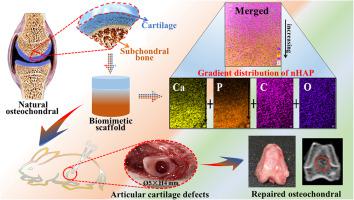Colloids and Surfaces B: Biointerfaces ( IF 5.4 ) Pub Date : 2021-09-16 , DOI: 10.1016/j.colsurfb.2021.112116 Gan Xu 1 , Yao Zhao 2 , Yusheng Geng 2 , Shujun Cao 3 , Panpan Pan 3 , Jianhua Wang 2 , Jingdi Chen 3

|
Osteoarthritis disease can easily lead to articular cartilage degeneration and subchondral bone damage, so the demand for suitable articular substitutes is gradually increasing. In order to simulate the complex environment of different layers in natural joint, we fabricate the continuous one-phase gradient scaffold. In the study, CS (chitosan) was modified with SH (sodium hyaluronate) and GO (graphene oxide) to form the whole scaffold. nHAP (Nano-hydroxyapatite) was in situ generated with gradient distribution in the scaffold. Continuous interface can better imitate the combination style of cartilage and subchondral bone at joint. The diverseness of scaffold’s different layer in water absorption/retention rate and mechanical property is similar to the difference of articular cartilage and subchondral bone. Meanwhile, the cell experiments demonstrated that the bionic scaffold can well promote the proliferation of bone marrow mesenchymal stem cell. Articular defect model further confirmed that the scaffold can better induce articular regeneration. Herein, the prepared scaffold might be an excellent candidate for endogenous articular repair.
中文翻译:

用于关节修复的纳米混合梯度支架
骨关节炎疾病容易导致关节软骨退变和软骨下骨损伤,因此对合适的关节替代品的需求逐渐增加。为了模拟天然接缝中不同层的复杂环境,我们制作了连续的单相梯度支架。在研究中,CS(壳聚糖)用 SH(透明质酸钠)和 GO(氧化石墨烯)修饰以形成整个支架。nHAP(纳米羟基磷灰石)在支架中以梯度分布原位生成。连续界面可以更好地模拟关节处软骨和软骨下骨的结合方式。支架不同层在吸水/滞留率和力学性能方面的多样性类似于关节软骨和软骨下骨的差异。同时,细胞实验表明,仿生支架能很好地促进骨髓间充质干细胞的增殖。关节缺损模型进一步证实支架能更好地诱导关节再生。在,准备好的支架可能是内源性关节修复的极好候选者。











































 京公网安备 11010802027423号
京公网安备 11010802027423号